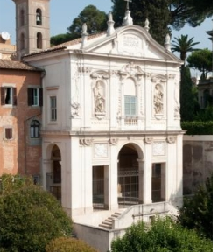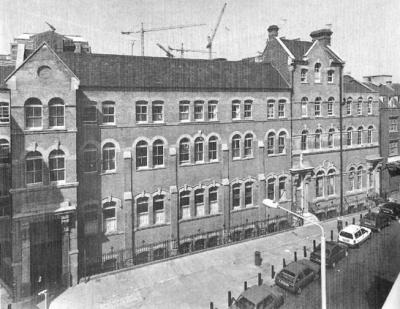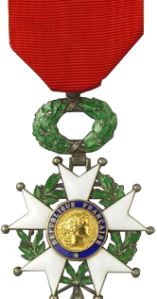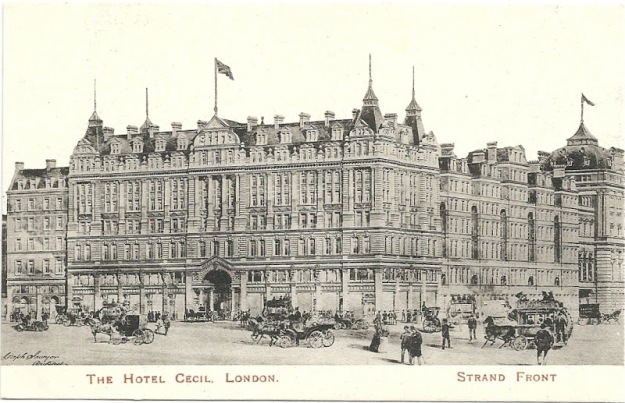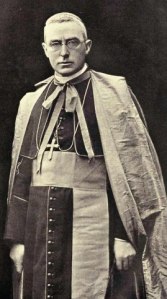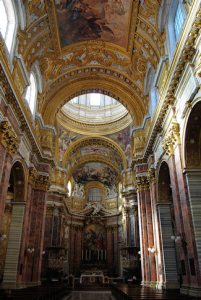
There has always been a certain amount of mystery about John Roper Parkington. His Catholic Who’s Who entry (1908) tells us “He was the son of John Weldon Parkington, and received his education at private schools in England and France.” This has always seemed slightly curious, and a rather convenient way of side-stepping questions about his background. It gives the appearance of some limited pedigree, and a quite clever explanation of why he didn’t attend an English public school whilst still giving the impression of a certain gentility. His entry also says “Sir Roper Parkington was a convert to the Church,” So depending on when that happened he should really be showing up in the records of either CofE or Catholic public schools of which there were beginning to be quite a few in 1850, except of course he “received his education at private schools in England and France.”
Marie-Louise Roper Parkington is rather easier to trace back. This post is really about what we know so far about both their early lives, up to about 1881 where they have been married eight years, and all four children had been born. The year 1881 was also the year their son Silvester John had died aged four.
The Roper Parkingtons are easy to place in 1881. They clearly appear in the UK census, and are living in Surbiton in a house called South Bank Lodge. Clearly doing well, by this point JRP is calling himself a wine shipper. The household includes two nurses for the three girls, a cook and housemaid, and a gardener and his wife. Oakhill, the part of Surbiton they are in is a leafy, well-to-do area, about 10 miles from central London, but connected to London by the railway which had arrived as early as 1838.
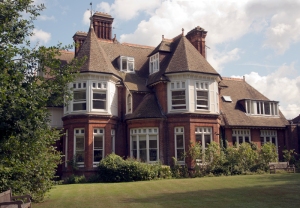
So both of them doing very well, but how did they get there, and what’s true and what needs to be taken with a pinch of salt? Neither of them are particularly accurate about their ages in the census returns. By 1881, he has knocked two years off his age which he keeps up for the rest of his life. She has knocked four years off hers, she ages somewhat in the 1890’s so she claims to be fifty in the 1901 census rather than fifty two, but the anti-ageing process kicks in again in the 1900’s so she only ages eight years that decade claiming to be fifty eight in 1911.
So what’s actually true?
He consistently states on his census returns that he was born in Ipswich, in Suffolk, and there is a record in the England & Wales, Civil Registration Birth Index for the second quarter [April – June] of 1843 of a John Roper Parkington’s birth being registered in Ipswich.

As we’ll see slightly later, this will more likely be the registration district that covers Mendlesham,in Suffolk, about twenty miles north of Ipswich.
Marie Louise Roper Parkington (nee Silvester) is also consistent in stating she was born in Stone, Staffordshire, and again there is a record in the England & Wales, Civil Registration Birth Index for the first quarter of 1849 of a Marie Louise Silvester’s birth being registered in Stone.

So we appear to have both of them outside London. Him in Suffolk, and her in Staffordshire.

She is easy to track from then on. Her father Abraham Sims Silvester is living in Stone, Staffordshire. He lists his occupation as a drapery manufacturer ” employing 60 heads” so running a substantial business. Abraham Silvester is sufficiently prosperous to send all his children to boarding schools with both Edward, and Louis, Marie Louise’s elder brothers going to Stonyhurst [founded in 1593]. She herself was sent to the Bar Convent in York. It claims to be the oldest surviving Roman Catholic convent in England, established in 1686. Their sister Elizabeth seems to have been educated by Benedictine nuns at Oulton Abbey, near Stone. So all of the children at absolutely blue-chip Catholic schools, well possibly not Elizabeth.
By 1861, Abraham Silvester has switched from drapery to shoe manufacture, or possibly just extended the business to include shoe manufacture as well; and then by 1871, the family has moved to London. On the 1871 census, Abraham Silvester is describing himself as a “member of the Stock Exchange” and entertainingly Great,Great,Great Granny Silvester is described as a “stockbroker’s wife”. She doesn’t bother with a profession when he’s manufacturing things.
So, in 1871, they are in Chiswick, at no.6, The Terrace, Turnham Green. Now Turnham Green Terrace. The house is also called Stanhope Lodge, (no.6, the Terrace). It must have been demolished, because the current no.6 Turnham Green Terrace is currently Charlotte’s Bistro, with flats above in a very typical late Victorian terrace. Certainly not grand enough for Abraham, Mary, and two adult children, and a servant.
Turnham Green was regarded as a separate village from “old” Chiswick which was the area on the river surrounding St Nicholas’s church, and it was rapidly changing from a village outside London into an almost connected suburb as London expanded hugely, and spread outwards. To quote from “www.british-history.ac.uk”:

“Little business was carried on in 1832 at Turnham Green, where many Londoners had country homes or lived in retirement. In 1845 it was thought that the scattered houses around the common, where there were already a few terraces, presented a welcome variety after the unbroken line of building along the road from London, although the common would benefit from inclosure and planting….The opening of railway stations in 1869 confirmed the importance of the area along the high road. From 1871 a furniture depository overlooked Turnham Green common, which by 1876 was surrounded by shops and houses, giving the place a ‘modern look’.”
So the Silvesters are doing well, and living in some style on the outskirts of London, but crucially the railway had arrived two years earlier, allowing train travel into central London.
John Roper Parkington is harder work. Much, much, harder work.
Tracing both of them back from 1881 the next solid detail is actually a newspaper notice from forty two years later in 1923 celebrating their Golden Wedding. “ROPER-PARKINGTON—SILVESTER.—At the Church of Our Lady of Grace, Chiswick, W., on June 21st, 1873, by the Rev. F. Doherty, MR., assisted by the Very Rev. Abbot Burder, J. Roper-Parkington, J.P., of Melbourne House, Chiswick, to Marie Louise, daughter of the late A. Sims Silvester, Esq., of Stanhope Lodge. Chiswick, and of the Stock Exchange.” It’s a copy of the original marriage notice in the Tablet, and places them both in Chiswick. Her, in Turnham Green Terrace, and him, literally at the end of the road, on the corner of South Parade, and what is now the Avenue, though in 1873 yet to be developed. Melbourne House is still standing, and when last on the market was described as follows:

“Built in 1794 by John Bedford, Melbourne House is one of the oldest surviving houses in Chiswick. It has been lovingly restored throughout although the original layout has gone relatively unchanged. Beautiful high ceilings, large sash windows, original features and an incredible garden all make this a superb and highly sought after property. Accommodation:
Reception room, dining room, family room, master bedroom suite with his and hers dressing rooms, en suite bathroom and private dressing room, 5 further bedrooms, 3 further bathrooms, kitchen/breakfast room, cloakroom, utility room, vast garden, off street parking.”
It sold for just over £ 5m. in 2012, though I suspect that the house was either rented, or on a fairly short lease, but still not a bad start to married life. All the children were born in Chiswick, so we can probably assume they were born in Melbourne House, and moved to Surbiton after Aunt Irene was born in June 1878.
So in 1873, John Roper Parkington was well-off, already a magistrate [at least according to the notice from 1923, but with the caveat that his grasp on dates can be hazy]. JR Parkington & Co. has been in business five years, it was established in 1868. At the time of their marriage he is thirty years old, and she is twenty four. They marry at St Mary’s Church, as it then was. It is now Our Lady of Grace, and St Edward, having been rebuilt in the 1880’s, but still on the same site, – the corner of Duke’s Avenue and Chiswick High Road. My guess is that this is the point that he converted to Catholicism.
The next record takes us back only another two years to 1871, but it adds to, rather than solves, the mystery. In 1871, the census records a “J R Parkington, 28, Wine Merchant, Ipswich, Suffolk,” living at 18 Clark Street, in Mile End Old Town. He is listed as the stepson of “M Howell, 60, retired officer Customs [born] Wexford, Ireland” who is the head of the household, and his wife “E H Howell 49, Suffolk”, and a nineteen year old servant Cath Horrigan.
Clark Street is firmly in the East End, running roughly parallel with Whitechapel Road, and Commercial Road. It’s about a mile and a half north of the London Docks, and on the eastern fringes of Whitechapel. It’s not classic Dickensian “rookeries” i.e absolute slums. It’s more respectable than that. Charles Booth, the English social researcher who mapped poverty levels almost twenty years later described Clark Street as “Mixed. Some comfortable, others poor.”. Poor in the context of 1889 was a family living on 18s. to 21s. Comfortable was as high as Booth’s classification of “F Higher class labour and the best paid of the artisans. Earnings exceed 30s per week. Foremen are included, city warehousemen of the better class and first hand lightermen; they are usually paid for responsibility and are men of good character and much intelligence.”. That was twenty years later, and the area could , and almost certainly would, have changed, but it is firmly a mixed working class district.
The Howells are unusual,both in occupying the whole house; which appears to be a flat-fronted three storey Victorian terraced house, with probably two rooms on each floor, and a kitchen/scullery extension on the ground floor. They also have a servant, unlike the neighbours who in some cases are servants. In 1871, most all the surrounding houses are shared by a number of families, and the professions range from a schoolmistress, wool machinist, bricklayer, draper’s porter, engine fitter, waistcoat maker to a master bricklayer “employing four men” to a out of work labourer
The range of neighbours in 1861 is largely similar, including a cooper, a cigar maker. Next door at no. 19 are four separate households with a dock labourer, the wonderfully named Allen Allen, a tailor from Essex, a lighterman, and a seamstress, whilst next door to them are a dairywoman, and her son, and a silk weaver and a grocer next to them. At no.18 are “Michael Howell, 50, Head. Officer in HM Customs, Ireland. Elizabeth Howell, 37, wife, Suffolk, Rendlesham, James(sic) R Parkington 17 stepson wine merchant clerk Suffolk, Ipswich, and Fanny Roper 35 sister Suffolk ,Mendlesham,”
So we appear to have John Roper Parkington living in the East End for at least a decade between 1861 and 1871 on the fringes of Dockland. The ages are just about right [17 in 1861, and correctly, 28 in 1871]. The profession is right, and by 1871, he had established JR Parkington & Co a couple of years earlier; and the birthplace is right.
This had been a brick wall for ages, and I am very grateful to Peter Agius for some sleuthing where he came up with the next records.
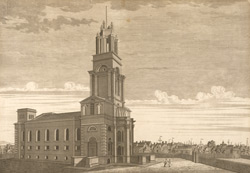
On the 31st May 1842, a “John Wilden Parkington and Elizabeth Rooper” got married at St Anne, Limehouse. I like the circularity of this because it is where both Roger Purssell (1783-1861) and Charlotte Peachey (1789-1886) were christened, and then later married in 1810. It was also where all their children were christened between 1811 and 1831, starting when Aunt Charlotte was christened, and finishing with Great, Great Grandpa Alfred [Purssell] the youngest son.
This must almost certainly be JRP’s parents, but it’s just as frustrating. Up until now we had nothing on John Weldon Parkington, apart from the fact he had a son. Now, at least, we know he must have been born before 31st May 1821, because he was “of full age” ,and that his father was called Thomas Parkington [who according to their marriage licence had “died”. No other profession. Her father is John Roper, who is a “victualler” , so running a pub.
The next record that comes up is the census for 1851, where John Roper, aged fifty-five is living in Hunston, Suffolk with his wife Elizabeth [57], twenty-five year old daughter Frances, and a seven year-old grandson J R Parkington. John Roper is described as a “farm bailiff”. All the Ropers were born in Mendlesham, Suffolk, about eleven miles east of Hunston. Ipswich, where JRP was born, or his birth was registered, is about sixteen miles due south. There are too many elements in this for it not to be true. The Roper surname becoming a middle name is standard practice in families, Frances Roper, then aged thirty-five, is living with Michael, and Elizabeth Howell, and her son “James(sic) R Parkington 17″ in Mile End in 1861. We also have a record of Michael Howell and Elizabeth Ann Parkington marrying in the autumn of 1849 in the Stepney registration district which includes Mile End Old Town.
So, we’ve tracked down JRP, his mother, step-father, maternal grand-parents, aunt, and had a glimpse of his father, and grandfather.
None of this explains how an East End boy gets together with a West End girl within eighteen months of moving to Chiswick, or where his money comes from, or whether he is hiding his background, and if so from whom?





